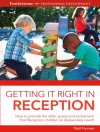Build the behavior system your students need and deserve
Students deserve a safe, welcoming, and tolerant learning environment in which high expectations for academic and social/emotional learning will flourish. To achieve this, schools must implement consistent behavior initiatives that are rooted in equity and clear in outcome and purpose. Which plan is best for your students’ needs?
In Building Behavior, authors Jessica Djabrayan Hannigan and John Hannigan identify the strengths of six major research-based behavior initiatives and offer practical guidance for implementing one or more that meet the unique needs of your students and school. They explore and connect the relationship of effect sizes and influence of six common behavior initiatives—Positive Behavior Interventions and Supports, Character Education, Restorative Justice, Culturally Responsive Teaching, Trauma Informed Practices, and Social and Emotional Learning—to help educators understand the purpose of each and give school leaders a starting point for adding to, refining, or building a tailored behavior system that is effective and manageable. Building Behavior includes:
- Common definitions, frameworks, best practice resources, and tips for implementing and synthesizing each of the behavior initiatives
- Reflective prompts that connect the existing body of knowledge with real life experiences and practices
- Reproducible resources, including sample schoolwide and district-wide assessments
- Tips to avoid common implementation challenges and missteps
Don’t just reach for the ‘next best thing.’ Learn to select, self-assess, and build a plan for effective implementation of a behavior system that meets the diverse academic and social/emotional learning needs of your students.
– Mandy White, Science Teacher, Vicenza Middle School, U.S. Department of Defense Education Activity
表中的内容
Acknowledgments
About the Authors
PART I • BUILDING BEHAVIOR (THE WHY)
Chapter 1 • Building Effective Behavior Initiatives in Schools
The Why Behind This Book
How to Use This Book: Building Behavior
Behavior Initiatives K-W-L Strategy
Before You Begin: An Important Note
PART II • BUILDING BEHAVIOR (THE WHAT)
Chapter 2 • Positive Behavior Interventions and Supports
The What—Positive Behavior Interventions and Supports (PBIS)
Connection to Hattie’s Effect Sizes in Relation to the Core Components of PBIS
Synthesized Indicators of PBIS Implementation Success and Challenges
PBIS Best-Practice Resource Inventory
Chapter 3 • Character Education
The What—Character Education
Connection to Hattie’s Effect Sizes in Relation to the Core Components of Character Education
Synthesized Indicators of Character Education Implementation Success and Challenges
Character Education Best-Practice Resource Inventory
Chapter 4 • Restorative Justice
The What—Restorative Justice
Connection to Hattie’s Effect Sizes in Relation to the Core Components of Restorative Justice
Synthesized Indicators of Restorative Justice Implementation Success and Challenges
Restorative Justice Best-Practice Resource Inventory
Chapter 5 • Culturally Responsive Teaching
The What—Culturally Responsive Teaching (CRT)
Connection to Hattie’s Effect Sizes in Relation to the Core Components of CRT
Synthesized Indicators of CRT Implementation Success and Challenges
CRT Best-Practice Resource Inventory
Chapter 6 • Trauma-Informed Practices
The What—Trauma-Informed Practices (TIPs)
Connection to Hattie’s Effect Sizes in Relation to the Core Components of TIPs
Synthesized Indicators of TIPs Implementation Success and Challenges
TIPs Best-Practice Resource Inventory
Chapter 7 • Social and Emotional Learning
The What—Social and Emotional Learning (SEL)
Connection to Hattie’s Effect Sizes in Relation to the Core Components of SEL
Synthesized Indicators of SEL Implementation Success and Challenges
SEL Best-Practice Resource Inventory
PART III • BUILDING BEHAVIOR (THE HOW)
Chapter 8 • Bringing It All Together: Building Behavior Initiatives
Bringing It All Together: Synthesis of the Six Behavior Initiatives
School Wide Behavior Initiatives Process (SW-BIP)
SW-BIP Phase 1: Selection
SW-BIP Phase 2: Self-Assessment
SW-BIP Phase 3: Solutions
Closing Thoughts: Tips and Suggestions from the Authors
References
Index
关于作者
Dr. John Hannigan has served in education for over 20 years as a teacher, instructional coach, principal, and county office leadership coach. John is a sought-after consultant who works with schools and districts across North America on designing and implementing systematic multi-tiered systems of support for both academics and behavior. Dr. Hannigan holds a doctorate in Educational Leadership from California State University, Fresno. As principal of Reagan Elementary in California′s Sanger Unified School District, John played a key role in the school earning California State Distinguished School, California Title I Academic Achievement Award, Gold Ribbon School, California Honor Roll School, Bonner Award for Character Education, and Platinum Level Model School Recognition for positive behavior interventions and supports. John has written numerous articles and co-authored nine books. He is the co-founder of Hannigan Ed-Equity Group LLC. Connect with him on Twitter @John Hannigan75












